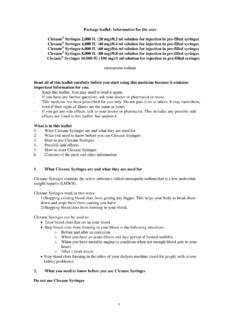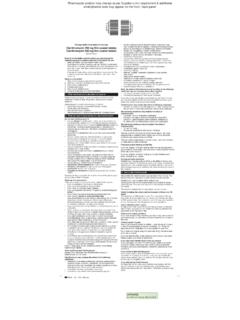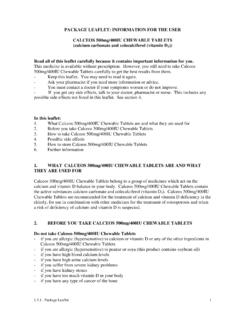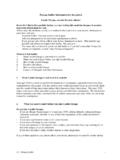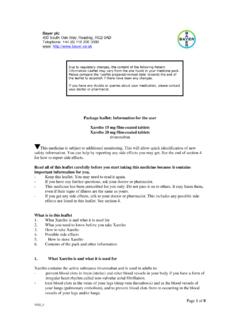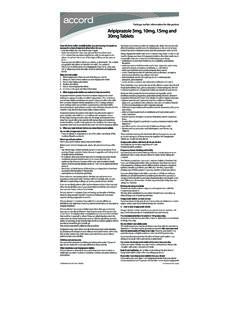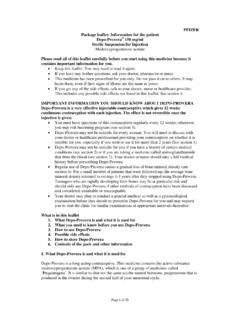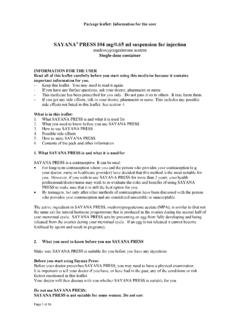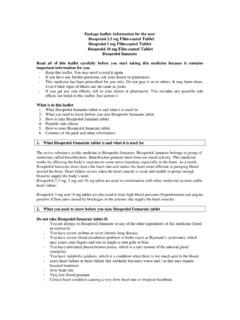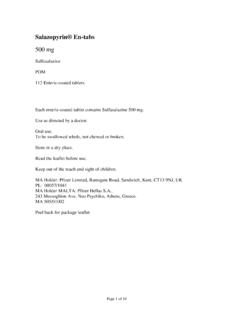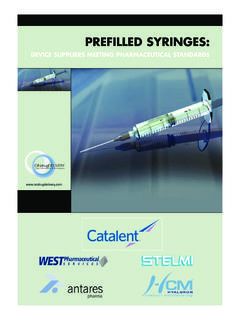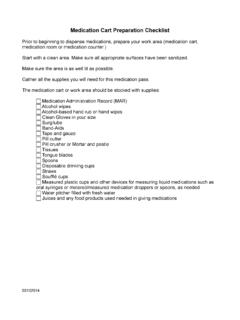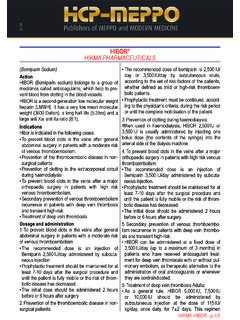Transcription of Package leaflet: Information for the user Kineret 100 …
1 1 Package leaflet: Information for the user Kineret 100 ml solution for injection in pre- filled syringe Anakinra Read all of this leaflet carefully before you start using this medicine because it contains important Information for you. - Keep this leaflet. You may need to read it again. - If you have any further questions, ask your doctor or pharmacist. - This medicine has been prescribed for you only. Do not pass it on to others. It may harm them, even if their signs of illness are the same as yours. - If you get any side effects, talk to your doctor or pharmacist. This includes any possible side effects not listed in this leaflet. See section 4. What is in this leaflet 1. What Kineret is and what it is used for 2. What you need to know before you use Kineret 3. How to use Kineret 4. Possible side effects 5. How to store Kineret 6. Contents of the pack and other Information 1.
2 What Kineret is and what it is used for Kineret contains the active substance anakinra. This is a type of cytokine (an immunosuppressive agent) that is used to treat: - Rheumatoid Arthritis (RA) - Cryopyrin-Associated Periodic Syndromes (CAPS) which includes the following auto-inflammatory diseases: - Neonatal-Onset Multisystem Inflammatory Disease (NOMID), also called Chronic Infantile Neurological, Cutaneous, Articular Syndrome (CINCA), - Muckle-Wells Syndrome (MWS), - Familial Cold Autoinflammatory Syndrome (FCAS) - Still s disease including Systemic Juvenile Idiopathic Arthritis (SJIA) and Adult-Onset Still s Disease (AOSD) Cytokines are proteins made by your body that co-ordinate communication between cells and help control cell activity. In RA, CAPS and in Still s disease, your body produces too much of a cytokine called interleukin-1. This results in harmful effects leading to inflammation, causing the symptoms of the disease.
3 Normally, your body produces a protein that blocks the harmful effects of interleukin-1. The active substance of Kineret is anakinra, this works in the same way as your natural interleukin-1 blocking protein. Anakinra is produced by DNA technology using the micro-organism E. coli. For RA, Kineret is used to treat the signs and symptoms of the disease in adults (age 18 years and over) in combination with another medicine called methotrexate. Kineret is for patients whose response to methotrexate on its own is not good enough to control the rheumatoid arthritis. For CAPS, Kineret is used to treat the signs and symptoms of inflammation associated with the disease such as rash, joint pain, fever, headache and fatigue in adults and children (age 8 months and older). For Still s disease, Kineret is used to treat the signs and symptoms of inflammation associated with the disease such as rash, joint pain and fever.
4 2 2. What you need to know before you use Kineret Do not use Kineret - if you are allergic to anakinra or any of the other ingredients of this medicine, listed in section 6; - if you are allergic to other products that are produced by DNA technology using the micro-organism E. coli; - if you have neutropenia (low white blood cell count) determined after a blood test. Contact your doctor immediately - if you get a rash all over your body, shortness of breath, wheezing, fast pulse or sweating after your Kineret injection. These may be signs that you are allergic to Kineret . Warnings and precautions Talk to your doctor before using Kineret : - if you have a history of recurring infections, or if you suffer from asthma. Kineret may worsen these conditions; - if you have cancer. Your doctor will have to decide if you can still be given Kineret ; - if you have a history of increased levels of liver enzymes; - if you require vaccinations.
5 You must not be given live vaccines while being treated with Kineret . Still s disease - Patients with Still s disease may develop a condition called macrophage activation syndrome (MAS), which can be life-threatening. The risk for developing MAS is increased if you have an infection or if your Still s disease symptoms are poorly controlled. Symptoms of MAS can be persistent high fever, swelling of lymph nodes, and persistent rash. If you develop signs of an infection or worsening of your Still s disease symptoms you should contact your health care provider as soon as possible. Children and adolescents - RA: Use of Kineret in children and adolescents with Rheumatoid Arthritis has not been fully investigated and therefore cannot be recommended. - CAPS: Kineret is not recommended for children younger than 8 months of age because there is no data in this age group. Other medicines and Kineret Tell your doctor if you are taking, have recently taken or might take any other medicines.
6 Medicines called tumour necrosis factor (TNF- ) inhibitors, such as etanercept should not be used with Kineret because this may increase the risk of infections. When you start taking Kineret the chronic inflammation in your body will decrease. This could mean that the doses of some other medicines, warfarin or phenytoin, have to be adjusted. Pregnancy and breast-feeding If you are pregnant or breast-feeding, think you may be pregnant or are planning to have a baby, ask your doctor for advice before taking this medicine. Kineret has not been tested in pregnant women. Use of Kineret is not recommended during pregnancy and in women of childbearing potential not using contraception. It is important to tell your doctor if you are pregnant, if you think you may be pregnant or are planning to have a baby. Your doctor will discuss with you the potential risks of taking Kineret during pregnancy.
7 It is not known whether anakinra is excreted in human milk. You must not breast-feed if you use Kineret . 3 Kineret contains sodium This medicine contains less than 1 mmol sodium (23 mg) per 100 mg dose, that is to say essentially sodium-free . 3. How to use Kineret Always use this medicine exactly as your doctor has told you. Check with your doctor or pharmacist if you are not sure. Kineret must be injected under your skin (subcutaneous) daily. You should try to have the injection at the same time each day. The recommended dose is either 20 to 90 mg or 100 mg. Your doctor will tell you the dose that you need or whether you need a dose higher than 100 mg. Injecting Kineret yourself Your doctor may decide that it would be more convenient for you to inject Kineret yourself. Your doctor or nurse will show you how to inject yourself. Do not try to inject yourself if you have not been trained.
8 For instructions on how to inject yourself or your child with Kineret , please read the Instructions for preparing and giving an injection of Kineret section at the end of this leaflet. If you use more Kineret than you should You should have no serious problems if you accidentally take more Kineret than you need. However, you should contact your doctor, nurse or pharmacist if this does happen. If you feel unwell in any way you should contact your doctor or nurse immediately. If you forget to use Kineret If you have forgotten to take a dose of Kineret , you should contact your doctor to discuss when you should take the next dose. 4. Possible side effects Like all medicines, this medicine can cause side effects, although not everybody gets them. Possible side effects are similar regardless if you are treated with Kineret for RA, CAPS or Still s disease. If any of the following happen, tell your doctor immediately: - Serious infections such as pneumonia (a chest infection) or infections of the skin can occur during Kineret treatment.
9 Symptoms might be persistent high fever, shivers, cough, headache, and redness and tenderness of the skin. Also persistent low-grade fever, weight loss, and persistent cough can be signs of an infection. - Serious allergic reactions are uncommon. However, any of the following symptoms may indicate an allergic reaction to Kineret , so you should seek immediate medical attention. Do not inject more Kineret . - Swelling of the face, tongue or throat - Trouble swallowing or breathing - Suddenly feeling fast pulse or sweating - Itchy skin or rash 4 Very common side effects (may affect more than 1 in 10 people): - Redness, swelling, bruising or itching at the injection site. These symptoms are generally mild to moderate and are more common at the start of your treatment. - Headaches. - Increased total blood cholesterol levels. Common side effects (may affect up to 1 in 10 people): - Neutropenia (low white blood cell count) determined after a blood test.
10 This might increase the risk of you getting an infection. Symptoms of infection might include a fever or a sore throat. - Serious infections such as pneumonia (a chest infection) or infections of the skin. - Thrombocytopenia (low level of blood platelets). Uncommon side effects (may affect up to 1 in 100 people): - Serious allergic reactions including swelling of the face, tongue or throat, trouble swallowing or breathing, suddenly feeling fast pulse or sweating and itchy skin or rash. - Elevated levels of liver enzymes determined after a blood test. Side effects with frequency not known (frequency cannot be estimated from the available data): - Signs of liver disorders such as yellow skin and eyes, nausea, loss of appetite, dark-coloured urine and light-coloured stools. Reporting of side effects If you get any side effects, talk to your doctor or pharmacist. This includes any possible side effects not listed in this leaflet.
